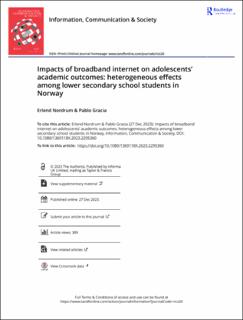| dc.contributor.author | Nordrum, Erlend Ingridsønn | |
| dc.contributor.author | Gracia, Pablo | |
| dc.date.accessioned | 2024-02-26T13:15:06Z | |
| dc.date.available | 2024-02-26T13:15:06Z | |
| dc.date.created | 2024-01-13T10:07:04Z | |
| dc.date.issued | 2023 | |
| dc.identifier.citation | Information, Communication & Society. 2023. | en_US |
| dc.identifier.issn | 1369-118X | |
| dc.identifier.uri | https://hdl.handle.net/11250/3119938 | |
| dc.description.abstract | The expansion of internet is likely to influence adolescents’ academic outcomes. Yet, how internet coverage impacts students’ educational performance remains poorly understood. To address this major knowledge gap, this study uses a quasi-experimental approach with Norwegian data to causally examine how the gradual introduction of home broadband internet across municipalities impacted the academic outcomes of lower-secondary school graduates (N = 103,796). Analyses apply sibling fixed-effects models with micro-level registry data from adolescents aged 15–16, and compare differences in effects by gender, social background, migrant status, and academic achievement levels. Findings show that the introduction of broadband internet across municipalities brought moderate grade improvements concentrated among boys in the subject areas of Mathematics, Arts and Crafts, Social Sciences, and Norwegian. The positive effect of broadband internet coverage on academic performance was three times larger for boys than for girls. For boys, broadband internet coverage led to strong grade improvements among the lower-achieving and socioeconomically disadvantaged, and to moderate grade benefits among those of Norwegian background, while boys from higher-achieving and socioeconomically privileged groups reduced their grades moderately. By contrast, for girls, broadband internet coverage worsened substantially the academic performance of those from disadvantaged socioeconomic backgrounds, whereas girls of migrant background obtained higher grades with this expansion of internet. The study findings reveal how the growth of internet coverage impacts adolescent educational performance, but differently across groups, showing a complex intersection across gender, social background, migrant status, and academic achievement levels. | en_US |
| dc.language.iso | eng | en_US |
| dc.publisher | Taylor & Francis | en_US |
| dc.rights | Attribution-NonCommercial-NoDerivatives 4.0 Internasjonal | * |
| dc.rights.uri | http://creativecommons.org/licenses/by-nc-nd/4.0/deed.no | * |
| dc.subject | adolescent academic outcomes | en_US |
| dc.subject | broadband internet coverage | en_US |
| dc.subject | digital divide | en_US |
| dc.subject | ICTs | en_US |
| dc.subject | secondary education | en_US |
| dc.subject | young people | en_US |
| dc.title | Impacts of broadband internet on adolescents’ academic outcomes: heterogeneous effects among lower secondary school students in Norway | en_US |
| dc.type | Peer reviewed | en_US |
| dc.type | Journal article | en_US |
| dc.description.version | publishedVersion | en_US |
| dc.rights.holder | © 2023 The Author(s). | en_US |
| dc.subject.nsi | VDP::Teknologi: 500::Informasjons- og kommunikasjonsteknologi: 550 | en_US |
| dc.subject.nsi | VDP::Samfunnsvitenskap: 200::Pedagogiske fag: 280 | en_US |
| dc.source.journal | Information, Communication & Society | en_US |
| dc.identifier.doi | 10.1080/1369118X.2023.2295360 | |
| dc.identifier.cristin | 2225779 | |
| cristin.ispublished | true | |
| cristin.fulltext | original | |
| cristin.qualitycode | 2 | |

